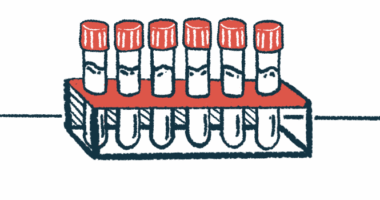MDA 2024: Blood biomarkers may help predict ALS progression rates
Researchers also looking at biomarkers to assess impact of Radicava therapies

New data show that blood-based measures, including levels of markers of nerve damage and chemical DNA modifications, can help predict which individuals with amyotrophic lateral sclerosis (ALS) will have faster disease progression over time.
However, because the disease course may be altered with Radicava or Radicava ORS — two formulations of edaravone approved in the U.S. and elsewhere for treating ALS — researchers also are looking at biomarkers that may predict the effects of these treatments in ALS patients.
“Results from this ongoing study may help to identify prognostic and disease monitoring markers of ALS and predictive … biomarkers of edaravone effect,” the scientists wrote in an abstract summarizing the findings of their work.
James Berry, MD, a professor of neurology at Harvard Medical School and a neurologist at the Massachusetts General Hospital, in Boston, presented the findings at the Muscular Dystrophy Association 2024 Clinical and Scientific Conference, being held this week in Orlando, Florida, and virtually. His talk was titled “Interim Analysis of the Radicava/Edaravone Findings in Biomarkers from ALS (REFINE-ALS) Study.”
Scientists are seeking new biomarkers to track ALS progression
Biomarkers are objective biological measurements that can provide meaningful clinical information about a disease. To date, there are no well-validated biomarkers to track disease progression or response to treatment in people with ALS, but many potential biomarkers have been identified and have shown promise in early studies.
Radicava was approved in the U.S. as an ALS treatment in 2017, making it the first new therapy for the disease in more than two decades. The original version of the therapy is given by infusion; an oral version called Radicava ORS was approved in 2022, and was designed to be more convenient and less burdensome for patients.
Both are given in an initial cycle of two weeks on therapy and two weeks off. In subsequent cycles, the therapy is taken daily over 10 days of the next two weeks, followed by two weeks of no treatment.
Mitsubishi Tanabe Pharma America, the company that sells Radicava and Radicava ORS in the U.S., sponsored a clinical trial called REFINE-ALS (NCT04259255) with the goal of assessing how these therapies affect potential biomarkers of ALS in the clinical setting.
The trial, which was launched in late 2019, “is designed to assess the effects of edaravone on blood biomarkers implicated in ALS in a real-world setting, as well as to look at ALS biomarkers themselves and try to give us more information about some of those,” Berry said.
The study enrolled 72 adults with ALS who started on either infused or oral Radicava formulations as part of their clinical care. Patients were followed for 24 weeks, or about six months — over six cycles of Radicava treatment.
The trial didn’t include a control arm; instead, the researchers compared findings from these participants with data from patients in a separate study called Answer ALS. For these comparisons, the researchers specifically selected patients with similar characteristics to those in REFINE-ALS, except not treated with Radicava.
Radicava use may have slowed ALS progression in trial participants
The last patient visit in REFINE-ALS took place at the end of 2023; Berry’s presentation covered interim data collected up to about a year ago, a few months before that last patient visit.
The available data showed that, after six months on Radicava, average scores on the ALS Functional Rating Scale-Revised (ALSFRS-R), a standardized a measure of physical function, worsened by 5.3 points in REFINE-ALS. By comparison, for patients in Answer ALS, average ALSFRS-R scores worsened by 6.3 points over six months.
The difference between the two groups wasn’t statistically significant in this interim analysis, but Berry said the trend “bodes well for our final analysis.”
One of the many biomarkers being tested in REFINE-ALS is EpiSwitch, a blood test that looks for epigenetic markers — chemical changes to DNA molecules that affect which genes are active and to which extent. This test is designed to provide early prognostic information to help predict whether individuals will have slow or fast disease progression.
Based on data collected at the study’s start, or baseline, EpiSwitch predicted that about 46% of patients in REFINE-ALS and 25% in the Answer ALS group would have a fast disease progression, while the remaining individuals had slow progression.
The scientists noted that average scores on the ALSFRS-R worsened faster in fast progressors than in slow progressors in both studies, which Berry noted as a “a victory for EpiSwitch.”
However, fast progressors who received any Radicava formulation tended to have less worsening after six months than those in Answer ALS (6.7 vs. 9.1). That finding suggests that Radicava treatment may have slowed ALS progression in these patients.
New techniques from REFINE-ALS are making trials easier on patients
Another biomarker assessed was neurofilament light chain (NfL), a structural protein in nerve fibers. When nerves are damaged, NfL is released into bodily fluids, so NfL levels in blood can be a useful way to track nerve damage.
Findings showed that patients in REFINE-ALS tended to start the study with higher levels of this biormarker than did those in Answer ALS. Also, those with higher NfL levels at the start of the REFINE-ALS trial tended to have more substantial disease progression in the following months.
Still, the team is encouraged by the data showing that, despite a “higher proportion of EpiSwitch fast predictions at baseline and a trend toward a slightly higher [NfL] at baseline in the REFINE-ALS population, we’re seeing very similar progression rates” in the two groups, Berry said.
Berry noted that other biomarkers, including measures of oxidative stress, will be included in the final analysis. Oxidative stress is a type of cell damage that occurs in ALS, and one of the main ways edaravone is thought to work is by reducing oxidative stress; thus, Berry and colleagues are particularly interested to see if they could be useful as measurements of treatment response.
“We’re encouraged by these results, and we look forward to the final analysis for what we can learn from this study,” he said.
In addition to findings from the trial itself, Berry noted that REFINE-ALS also has helped pioneer new techniques for running clinical trials.
The study launched near the start of the COVID-19 pandemic, and researchers had to quickly adapt to implement new ways to do biomarker and clinical testing without having patients come into hospitals.
Even though pandemic restrictions have eased considerably, these techniques are increasingly being used “to make trials and studies more palatable, easier for participants, and also to increase retention of participants over time,” Berry said.









